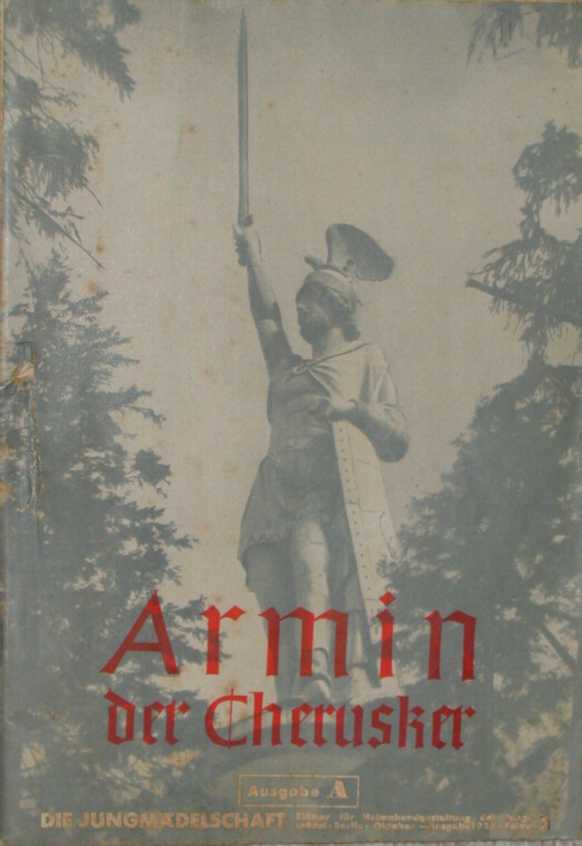


Background: The Hitler Youth (Hitlerjugend) was divided into sections for boys and girls. Each section devoted substantial energy to indoctrinating the youth with Nazi thinking. This page is a summary of an issue of the magazine aimed at leaders of groups of 10-11 year-old girls, giving them guidance on conducting the weekly meeting, or “home evening,” for the girls. It fits into the larger plan, outlined in the annual educational plan, for indoctrinating young girls. One should remember that a basic principle of propaganda is repetition. The girls heard this material not only in these meetings, but also in school, as well as in the media.
The source: Die Jungmädelschaft. Blätter für Heimabendgestaltung der Jungmädel, Ausgabe A, October 1938.

The cover shows a statue of Armin der Chersuker, an early German hero, and the subject of part of the issue.
The issue begins with a note to leaders of young girls. The summer season with its trips and camps is over. Now it is time for the winter program. “Once again, leader of young girls, you will receive the monthly folder with material for the home evening, which will give you the themes and content for arranging the home afternoons. In these home afternoons this winter, we will hear of the great figures of Germany’s past. The lives and deeds of these people are so clean, honest, and clear that they can be a model to young girls at any time.” The girls are to learn how fortunate they are. “Today’s young girl lives in Adolf Hitler’s Greater German Reich.... She should be thankful to be able to grow up in the Reich under Adolf Hitler’s leadership, in the Germany that fulfills the struggle of a thousand years, that realizes Germans’ dreams.”
There are 26 pages of material on Armin, which the leaders are to use in preparing for meetings with young girls.
Another 26 pages deal with the material young girls are to learn in the meetings. There were expected athletic achievements e.g., (running 60 meters in 12 seconds). There was also a fair amount of content to cover. There are examples of the minimum a girl should be able to say in answer to questions on that material. Here, for example, is what she is supposed to be able to say about Adolf Hitler’s early life:
“Adolf Hitler was born in Branau am Inn on 20 April 1889. His father was a customs official. Against his father’s will, he wanted to become an artist. At thirteen he lost his father, at sixteen his mother. Alone, he went to Vienna, where he had to earn his daily bread by hard work as an unskilled construction worker. He suffered. In spring 1912, Adolf Hitler went to Munich. At the outbreak of the World War in 1914, he volunteered and fought in France. He was a corporal and received the Iron Cross, First Class. In a hospital in 1918, he learned of the collapse of the Reich. He decided to become a politician. He became Führer of the NSDAP. On 9 November 1923, sixteen men of the movement fell before the Feldherrnhalle. Adolf Hitler was sentenced to five years in prison. On 30 January 1933, Reich President von Hindenburg appointed him Reich Chancellor. Thus, he became the Führer of the German people.”
There are similar examples for a variety of other topics.
Another page lists “sister” districts of the Jungmädel organization. Districts in Germany’s interior were paired with those along Germany’s borders with other countries. This section is introduced as follows:
“Because of the arbitrary borders imposed by the Treaty of Versailles, many border regions of the German Reich find themselves in difficult positions. Each Obergau of the Reich works works together in camaraderie with an Obergau on this side of the Reich border. The girls who live along the border should know that they do not stand alone. Each girl in the interior of the Reich must know the significance of the border.”
[Page copyright © 2006 by Randall Bytwerk. No unauthorized reproduction. My e-mail address is available on the FAQ page.]
Go to the German Propaganda Home Page.